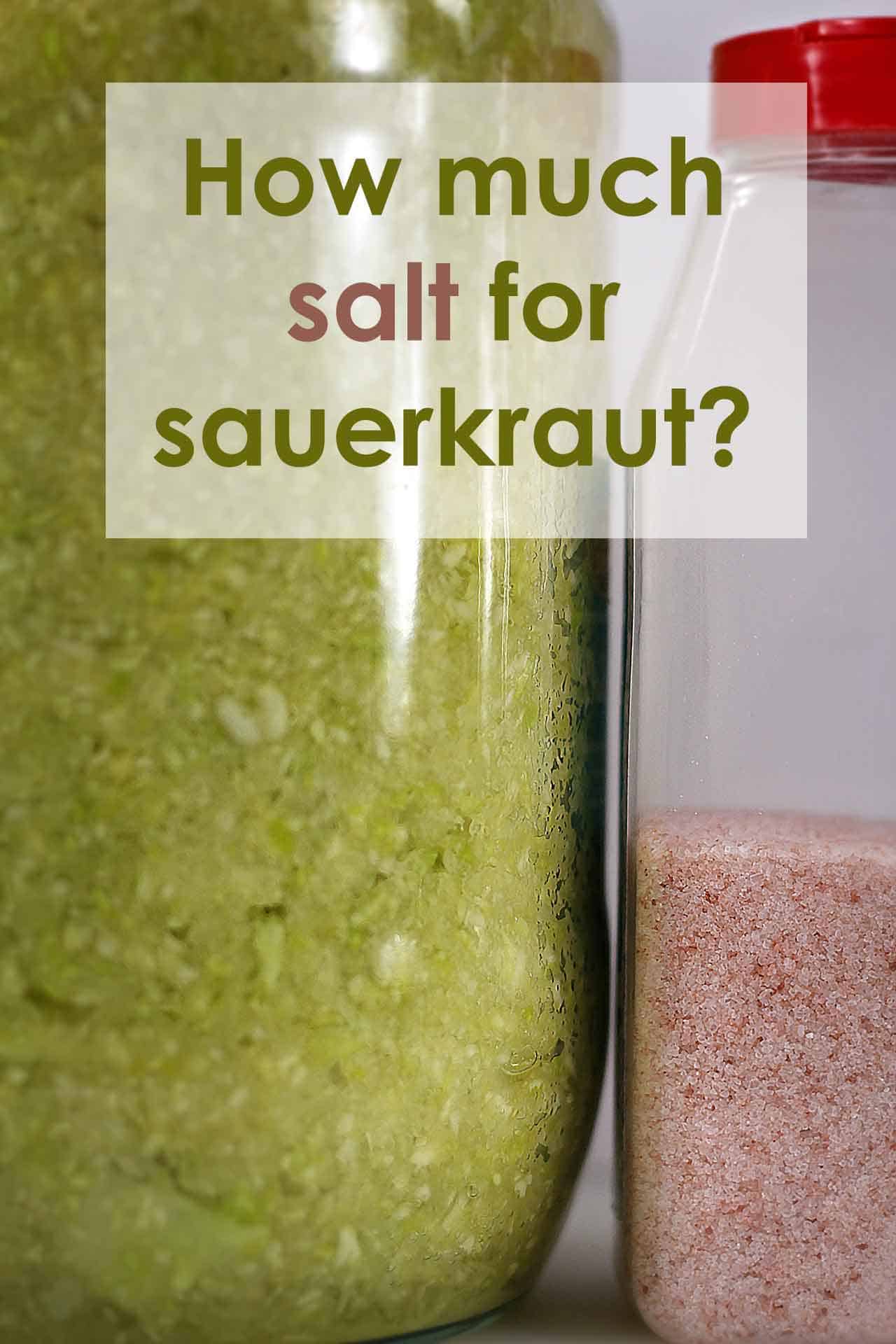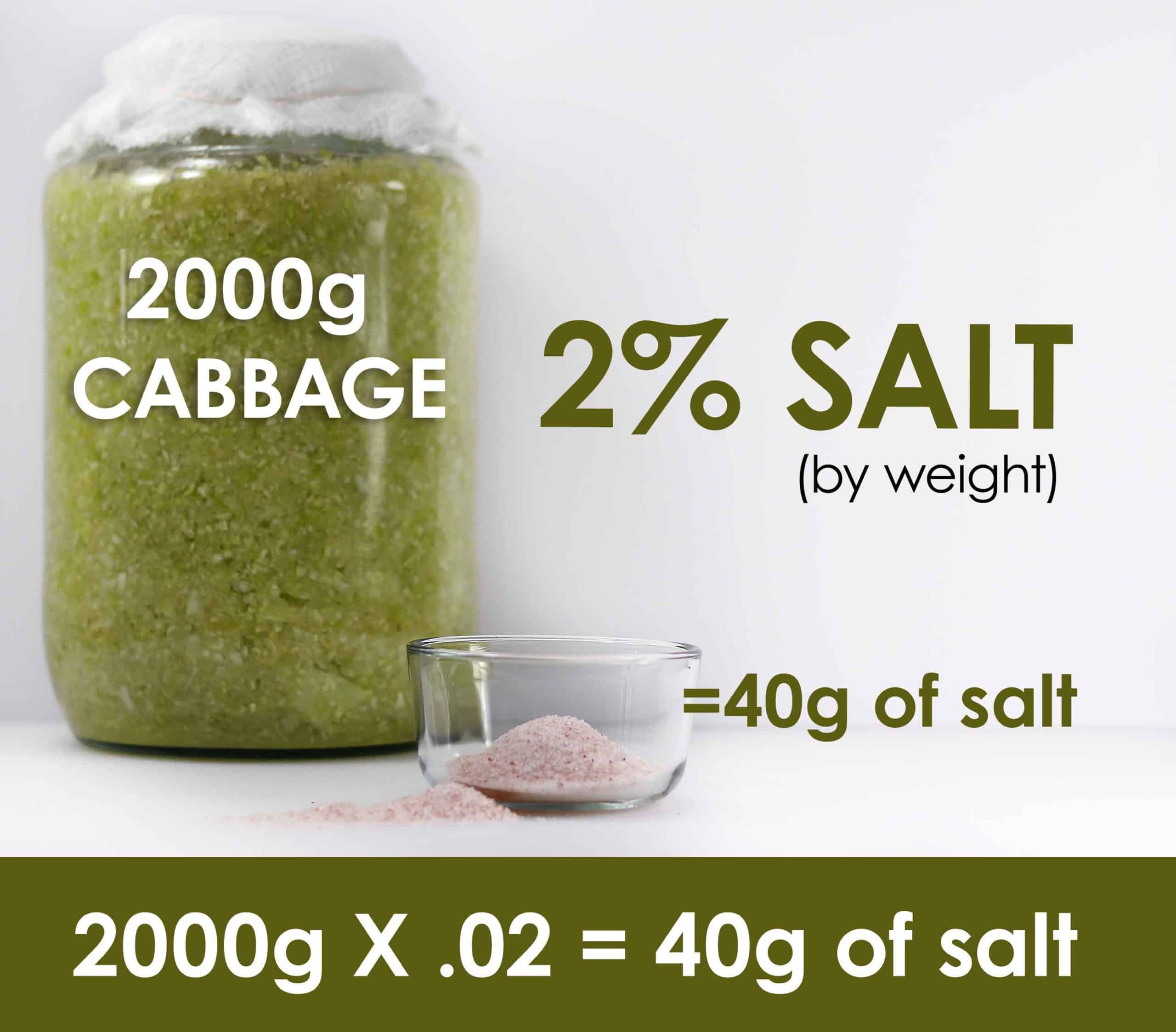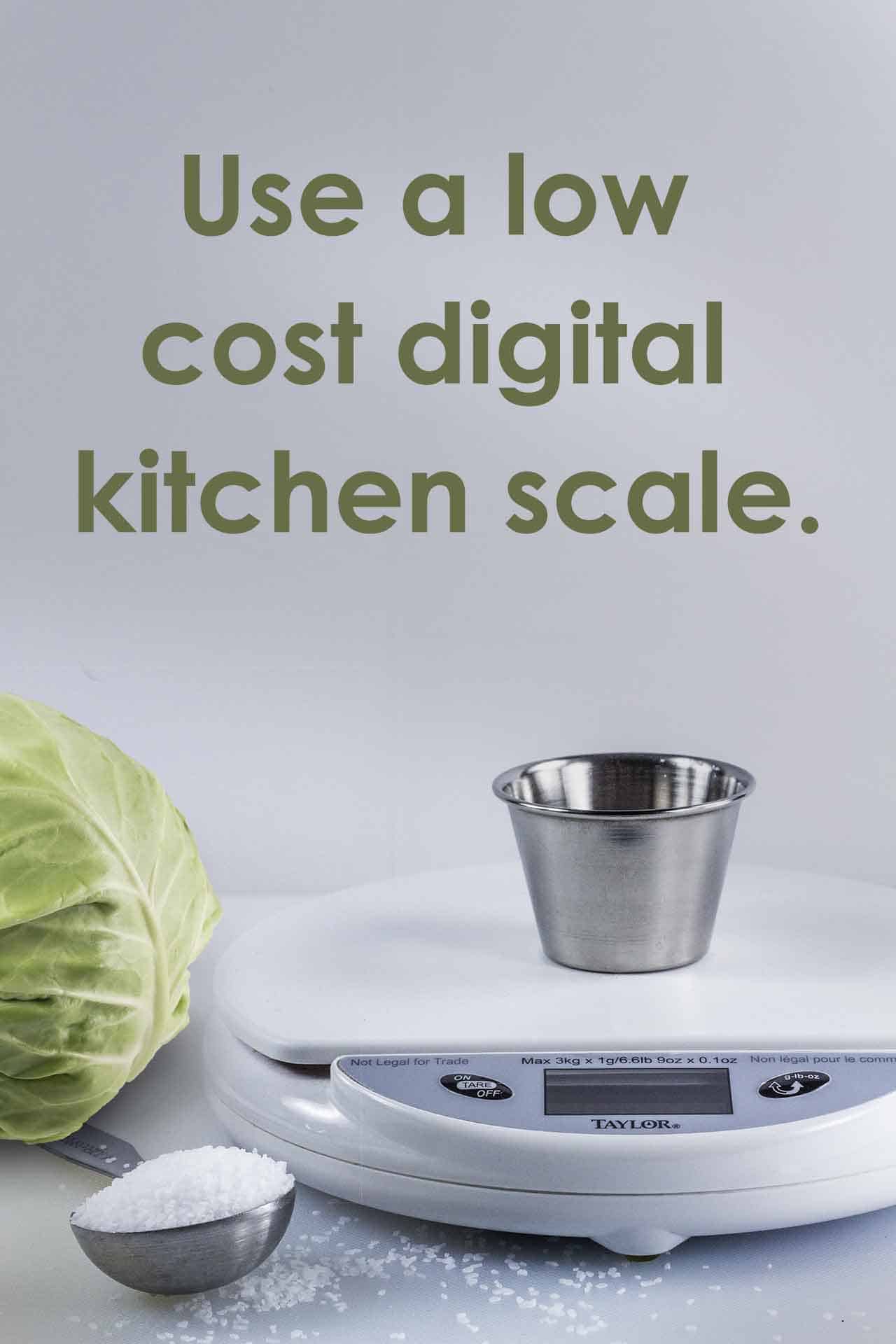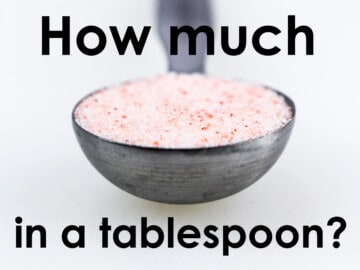
Sauerkraut – Using The Correct Amount of Salt
Making sauerkraut for the first time can be intimidating. I promise you, it doesn’t have to be. There are a few things you need to get right for a tasty, full flavored kraut.
The first (and most important) question I always ask myself is how much salt do I use for sauerkraut?
Expert sauerkraut makers agree on one thing. The amount of salt is critical to the quality and safety of your sauerkraut. Salt concentration recommendations range from 1.5% to 2.5% (depending on the source). But, 2% percent salt of the weight of your cabbage is my recommended starting point. It's a common and widely accepted concentration. This assumes your cabbage is fermenting in an 18°C to 21°C (64°F to 70°F) environment. As you keep reading, you’ll learn how to calculate this quickly for yourself.
In a nutshell, the method goes like this:
- Weigh your cabbage
- Do some math
- Weigh your salt
Seems fairly straight forward doesn’t it?
Step by Step Salt and Cabbage Measurements

Step 1 – Weigh your cabbage
First, weigh your cabbage using a digital kitchen scale.
By the way, I’m intentionally using the metric measurement of grams for this. It’s just easier to work with than the imperial system.
TIP:
Don’t weigh your cabbage in the condition you’ve purchased it from the market.
Instead, weigh it after you’ve torn off the outer leaves and removed the tough inner core.
The trick is to weigh the exact amount of cabbage that will end up in your sauerkraut.
For example, let’s say you’ve set your cabbage on a kitchen scale and it weighs exactly 2000g. (about two heads of cabbage)
Great, step one is done!

Step 2 – Do Some Easy Math
So, from step one, you know your cabbage weighs 2000g, right? For step two, take that number (2000g) and multiply by .02. Notice how the number “2” is in .02? That’s how you end up with 2% salt.
Wait, before we continue, a lot of our readers don't like math! So why not try our sauerkraut calculator directly below?
Type the number of grams of cabbage you have below:
For ??? of cabbage, you will need ??? of salt.
Note: This will give you a 2% salt to cabbage ratio. Which is exactly what you want!
After you multiply, you’ll end up with the number 40. That means 40g of salt is needed for 2000g of raw cabbage.
Let’s look at that again:
2000g of cabbage multiplied by .02 equals the number of grams of salt you need.
OR
2000g x .02 = salt
2000g x .02 = 40g of salt
This also works for any amount of cabbage!
Let’s change the amount of cabbage and see what happens.
If you have 200g of cabbage, it would look like this…
200g x .02 = 4g salt
What about 654g of cabbage?
Let’s do it.
654g x .02 = 13.08g salt (we’ll just say 13g even)
And just to make it sink in, let’s have a little fun.
What about 40,000g of cabbage!
No problem.
40,000g x .02 = 800g salt
Fantastic, step two is done.
Step 3 – Weigh your salt
Now, weigh your salt with a kitchen scale to match the answer you got above. That’s how much salt you should use. There are no tablespoons to measure here.
Next, find out why tablespoons are inaccurate when measuring salt for sauerkraut.
Fermenting Sauerkraut bonus resources:
Measuring salt is just one small part of making sauerkraut.
The University of Wisconsin-Madison and North Carolina State University have great information about fermenting vegetables, including sauerkraut:
You can find these at the links below. When you click on these links, a PDF will either open or download.
Recommendations for Safe Production of Fermented Vegetables
Vegetable Fermentation Safety Tips
And while you’re here…please do leave a comment. Ask a question. Let us know your experience or opinion. I’d love to hear it!
Happy Cooking!
Anton


Oriana says
your post has been extremely useful when yesterday I prepared, for my first time ever, my first fermented sauerkraut! I have just read a book by Dr. Perlmutter who recommends fermented vegs.
Thanks a lot from Rome (Italy)
Anton says
Hi Oriana,
Congratulations on your first batch of sauerkraut! I think that's great and happy I could help with that. Just curious, which book of Dr. Perlmutter did you just finish reading? Was it possibly "Brain Maker" by any chance?
Anton
Barbara Van dyck says
Is this the measurement for the brine that I need if the cabbage doesn’t have enough juice to cover it. Thanks
Anton says
Hi Barbara,
If your cabbage doesn't have enough juice to cover it...you can use the calculator on this page for calculating 2% salt needed for top-off brine. (it's the same calculator for either cabbage OR top-off brine). Just enter the number of milliliters (ml) of water you are starting with in the calculator. Since ml and grams are the same when it comes to water, the calculator will work great for this.
Hope that helps.
Paso hrnic says
Also you can measure water on one litre water 2.5% salt
1000ml of water=25g of salt
Anton says
That's a good point.
This becomes really important when making 'top-off brine'. Which is homemade brine made by dissolving salt into water.
It's used to add extra brine if your cabbage is dry and doesn't produce enough brine on its own.
Using 2.5% salt, we say 1000ml of water x 0.025 = 25g of salt needed.
For beginners though, stick with 2.0%.
So, for 2% salt we say 1000ml of water x 0.2 = 20g of salt needed.
It's important to know that one milliliter (ml) of water is equal to one gram (g) of water. If you weighed one ml of water, it would show as one gram on a scale.
This is a trait unique to water.
So, for both equations (using 2.5% or 2.0%), we can refer to water in grams instead of milliliters...
For 2.5%:
1000g of water x 0.025 = 25g of salt needed.
OR
For 2%:
1000g of water x 0.2 = 20g of salt needed.
Now, because water's measurements are the same in grams OR milliliters, that means you can use the salt calculator on this page to calculate salt for top-off brine!
You measure your water in ml and type that number into the calculator. This will give you the amount of salt needed for your top-off brine.
Also know that we can only swap ml and g for WATER ONLY. Don't do this with cabbage. 1000ml of cabbage is NOT equal to 1000g of cabbage.
For example, if you took a measuring cup and filled it with 1000ml of cabbage, it definitely won't weigh 1000g on a scale.
For cabbage, only use the weight.
For water, you can either weight it (in grams), or measure it in a measuring cup (in milliliters).
Gillian says
Thank you for the calculation. In lock-down here in Sydney, Australia, I'm about to make my second (well, really third) attempt at sauerkraut. The first I threw out - I didn't have weights and I gave up (this was a year ago). I've since bought a crock (last June) and finally started using it last month. This attempt was fabulous - crunchy and delicious. I found your site today because I couldn't remember the ratio (using grams) of salt to cabbage. And, I really appreciate the detail and I've downloaded the resources from the University of Wisconsin to review as well. I hope you're staying safe and have access to healthcare if needed. kind regards, Gillian
Anton says
Hi Gillian,
It's great that you stuck with it and kept trying. I had a few discouraging batches when I first tried myself.
So far so good here, still healthy:). Hopefully the curve starts to flatten for everyone soon.
Tony Deaves says
I am virgin in this field, and looking for the ratio of salt to cabbage, I am disabled and have a lot stuff going and I found Sauerkraut as lot of my meds do my gut in but okay to eat it as I check first with my consultant doctor.
it has help a lot side affects of the meds and I feel more comfortable and it give a lift.
My only problem is the cost of buying the product ready made, so wanted to look into making it myself; which would keep the cost down for me.
I have looked at book on the subject but could find what ratio was for salt to cabbage; you have simply answered my question / query on that subject. So I give a big thank you.
Anton says
Hi Tony,
It's great you've found that sauerkraut helps you support your health.
I personally know someone eating fermented foods during and following long term use of antibiotics, so I hear you.
Making sauerkraut yourself will no doubt cut down the costs a lot.
And you're very welcome for helping you out with the salt ratio. I'm very happy you found it useful.
I wish you the best of luck with your fermenting.
Anton
DC Chambers says
Just put my second batch of sauerkraut away to ferment. My first was just one head, turned out rather well. I actually feel like I know what I'm doing after reading your wisdom. So glad to get accurate measurements and ratios. I'm bookmarking your site and hope to post again in a few weeks.
Anton says
Hi,
It makes me happy you're having success.
Accuracy with measurements and ratios eliminates a lot of issues, for sure.
And I appreciate the bookmark. See you soon.
Anton
Constance Evans says
Thank you for easy formula to make salt to cabbage ratio for making sauerkraut (the math is easy.)
I have a question about what kind of salt to use. It looks like pink Himalayan salt in the photo of the side by side jars.
Is this the best kind to use?
I look forward to your reply. (I have not used the reference sources but will check them for their salt comments .)
Anton says
Hi Constance,
You're quite welcome for the cabbage/salt ratio.
You are right, it is pink Himalayan salt in the picture.
It works perfectly fine for making sauerkraut.
The one I use doesn't contain additives such as iodine or anti-caking agents that regular table salt often (but not always) contains. These additives "may" interfere with the fermentation process. But, iodine isn't a that big of an issue, if at all.
I recommend any salt that only displays "salt" on its ingredients list.
Pink Himalayan salt is often recommended by some because of its trace elements and proposed health benefits. None of this is 100% proven by research, although there is some "loose" research that really just proves there is more research needed. These trace elements are such a small part of the salt itself, that you would possibly need to eat a ridiculous (or even dangerous) amount of it to obtain the health benefits.
The health benefits we should focus on are from the lactic-acid bacteria and nutrient accessibility from fermentation, not the salt itself.
Here are some suggestions for what salt to use, if, and only if they are pure salt without any additives listed on the ingredients list on the back of the packaging:
- Kosher salt
- Pickling salt
- Sea salt
- Coarse pickling salt (it works but it's really too coarse to dissolve quickly and easily)
Keep in mind these salt names are common in North America and may differ in your area.
If you come across a package that is called table salt, double check the ingredients. If it's nothing but salt, you're OK to use it. It's just that sometimes it has other things added to it.
Hope that helps you out.
Anton
Carol says
Your salt-to-cabbage ratio calculator is very helpful. Thank you! Last time I made sauerkraut I think I put in too my salt. Hoping for a better result this time!
Anton says
Hi Carol,
Happy you found it useful. Good luck this time round!.
mike says
Hi - thanks for the site\info.
You say that 2% of the weight is the correct ratio of salt.
But the site you link to above (Recommendations for Safe Production of Fermented Vegetables) says 2.25% is the proper ratio: "For example, in the production of sauerkraut, fresh cabbage is shredded and 2.25% salt is added."
How much variability in salt is acceptable, and how does more versus less affect the outcome?
Anton says
Hi and welcome Mike.
That's a good observation.
2% salt can be considered a general, acceptable standard.
It's a good concentration for someone who is just starting out. It keeps things simple.
However, the true range is more like 1.5% to 2.5%. Commercial producers of sauerkraut use a variety of concentrations in this range. A few may even exceed that range at both ends.
Keep in mind, commercial producers have access to temperature controlled environments, so they can alter the time and temperature in any salt range to get the result they want.
How does salt concentration affect the outcome?
Salt is one variable of three (time, temperature, and salt) that can affect the outcome.
Changing any one of these would mean adjusting the others to compensate.
Generally though...
The less salt used, the higher the risk of mushy sauerkraut.
Less salt also speeds up lactic acid bacteria growth, so there's higher risk of the natural growth progression of different bacterial species getting out of whack.
Shorter fermentation times or lower temperatures are often used to offset lower salt concentrations.
The opposite is true as well.
The more salt used, the slower bacteria will grow. Too much salt, and they'll barely grow at all.
In the higher salt range, longer fermentation times or warmer temperatures are used to offset higher salt concentrations.
Back to the 2%...
It puts you right in the middle of the range, which is a good place to start. You can experiment with other concentrations after getting a feel for 2%.
There's no perfect combination of salt, time and temperature. But since this is technically a science experiment in your own home, it's good to start with a baseline standard.
A reasonable starting point is 2% salt, a room temperature of (64°F to 70°F), (18°C to 21°C), and 3 to 4 weeks.
Of course, you'll read several conflicting variations of that which is not necessarily incorrect. But do start with a baseline and go from there in future batches.
Personally, I like to start three small sized batches of sauerkraut simultaneously, each at different salt concentrations. Do that, and you'll get direct feedback of the outcomes from the end results.
Ricardo Vazquez says
What salt brand do you use for lacto fermentation? Thanks
Anton says
Hi Ricardo,
Honestly I wouldn't worry too much about the exact brand name you use. There are just so many.
Instead, focus on the ingredients listed on the back of the package. Make sure it has only one ingredient...salt.
Many packages list other ingredients you should avoid such as Calcium Silicate (an anti caking agent), or Dextrose, to name a few.
You can avoid iodine if you wish, but iodine really won't affect your sauerkraut, contrary to the fear mongering out there.
To simplify things for you, look for something called "Canning & Pickling Salt" (any brand), which usually only lists 'salt' on the ingredients and nothing else. Always double check though.
Hope that helps you.
Anton
Jen says
Hi thank you for this site. I'm about to try my first fermenting of kraut. I have 100% pink himalayan salt but I find it much stronger in taste than sea salt or any other salt. Will this affect the amount of salt I should use and the fermenting process?
Anton says
Hi Jen,
Good for you for trying your first batch!
I'm not sure if you meant tastes stronger (in flavor profile) or tastes saltier. But hopefully the following will help you...
Short answer is no, it should not affect the amount of salt you use (in grams). Pink Himalayan salt has slightly less sodium content than other salts. But, not enough to start splitting hairs with your salt weight calculations.
It's best to judge how much salt you need by weighing the salt. Judging by tasting can be misleading, depending on your taste buds that particular day. For example, if you rarely add salt to your food, everything tastes saltier. Further, taste testing one type of salt right after another will leave the second one tasting less salty. This is because your taste buds get dulled by tasting the first salt.
When weighed in grams (not measured in tablespoons), on average, Pink Himalayan salt generally contains slightly less sodium than iodized table salt.
It can be deceiving, because when measuring in teaspoons, that's not always true depending on how fine the salt grains are. But you should never measure salt using spoons when fermenting.
Here's a good example for sodium content of different salts when measured in teaspoons.
If you measure your Pink Himalayan salt in grams, you 'should' end up with slightly less sodium content than with other salts. But not enough to drastically affect fermentation. And that 'should' cause your sauerkraut to taste slightly less salty. But our taste buds may tell us a different story because they're subjective.
That being said, consider ditching Pink Himalayan salt altogether. The additional minerals it has are in such small amounts that there's no health benefits to them. That's contrary to what you read on so many blogs, I know. But, take a look at some science based analysis of Pink Himalayan salt for yourself. It's eye opening. Scroll down to the video on that page, it's easier than reading the full article.
JEAN-CLAUDE EMILE PAUL LECLERCQ says
How long under tropical temperatures?
Anton says
Hi!,
Let’s say your room temperature is 25°C to 28°C (77°F to 82°F), but not higher. At 2% salt, fermentation may only take 7 to 10 days. But, if your temperatures are higher than this, you're asking for trouble. Honestly, even at 25°C to 28°C (77°F to 82°F), your sauerkraut may not turn out as well as below 25°C (77°F). Note that 18°C is ideal.
You have a couple of options:
1. Increase the salt to 2.5% to slow down and control runaway bacteria growth.
2. Ferment your cabbage in a cooler box with just enough ice to keep the ambiant temperature closer to 21°C (70°F) as best you can. You could use 2% salt with this method.
I know you're in a predicament living in a warm climate like so many others. But, I promise you you'll have better success trying to control temperature rather than messing with salt and short fermentation times. Bacteria are picky about temperature. It's best to give them what they want.
Richard l. Dent says
Im and old man and dont know gram measurmet i use pounds can you help me ? thank you
Anton says
Hi Richard,
For US Customary units . . .
The trick is changing the weight of your cabbage from pounds to ounces.
For example, let's say you have 2 pounds of cabbage. Each pound is equal to 16 ounces. So, you have 32 ounces of cabbage. (2 lbs X 16 oz per pound).
Then, take your ounces (which is 32) and multiply by 2% (meaning multiply by 0.02). That will give you 2% salt for your cabbage in ounces.
Here's the complete math:
(2 lbs) X (16 oz per pound) X (0.02 salt percentage) = amount of salt needed
2 X 16 X 0.02 = .64 oz of salt
You need 0.64 oz of salt for 2 lbs of cabbage.
Hope that helps you.
Anton